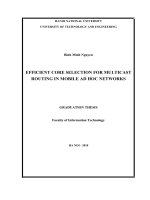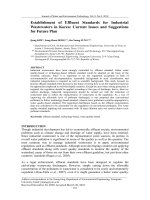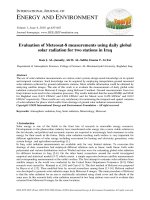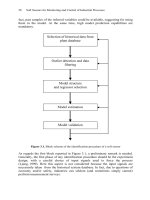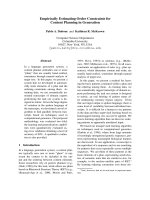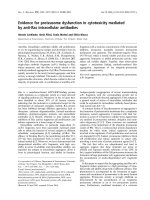Active sensors for local planning in mobile robotics by penelope probert smith
Bạn đang xem bản rút gọn của tài liệu. Xem và tải ngay bản đầy đủ của tài liệu tại đây (13.76 MB, 337 trang )
World Scientific Series in Robotics and Intelligent Systems - Vol. 26
ACTIVE SENSORS FOR
LOCAL PLANNING IN
MOBILE ROBOTICS
PENELOPE PROBERT SMITH
World Scientific
www.electronicbo.com
ACTIVE SENSORS FOR
LOCAL PLANNING IN
MOBILE ROBOTICS
WORLD SCIENTIFIC SERIES IN ROBOTICS AND INTELLIGENT SYSTEMS
Editor-in-Charge:
Advisor:
C J Harris (University of Southampton)
T M Husband (University of Salford)
Published:
Vol. 10: Cellular Robotics and Micro Robotic Systems
(T Fukuda and T Ueyama)
Vol. 11: Recent Trends in Mobile Robots (Ed. YFZheng)
Vol. 12: Intelligent Assembly Systems (Eds. M Lee and J J Rowland)
Vol. 13: Sensor Modelling, Design and Data Processing for Autonomous Navigation
(M D Adams)
Vol. 14:
Intelligent Supervisory Control: A Qualitative Bond Graph Reasoning
Approach (H Wang and D A Linkens)
Vol. 15:
Neural Adaptive Control Technology (Eds. R Zbikowski and K J Hunt)
Vol. 17: Applications of Neural Adaptive Control Technology (Eds. J Kalkkuhl,
KJ Hunt, R Zbikowski and A Dzielinski)
Vol. 18:
Soft Computing in Systems and Control Technology
(Ed. S Tzafestas)
Vol. 19: Adaptive Neural Network Control of Robotic Manipulators
(SSGe.TH Lee and C J Harris)
Vol. 20: Obstacle Avoidance in Multi-Robot Systems: Experiments in Parallel
Genetic Algorithms (MAC Gill and A YZomaya)
Vol. 21:
High-Level Feedback Control with Neural Networks
(Eds. F L Lewis and Y H Kim)
Vol. 22: Odour Detection by Mobile Robots
(R. Andrew Russell)
Vol. 23:
Fuzzy Logic Control: Advances in Applications
(Eds. H B Verbruggen and R Babuska)
Vol. 24:
Interdisciplinary Approaches to Robot Learning
(Eds. J. Demiris and A. Birk)
Vol. 25: Wavelets in Soft Computing
(M. Thuillard)
ACTIVE SENSORS FOR
LOCAL PLANNING
MOBILE ROBOTICS
PENELOPE PROBERT SMITH
University of Oxford, UK
V f e World Scientific
« •
NewJersev
London*• Sine
New Jersey'London
Singapore • Hong Kong
www.electronicbo.com
World Scientific Series in Robotics and Intelligent Systems - Vol. 26
Published by
World Scientific Publishing Co. Pte. Ltd.
P O Box 128, Farrer Road, Singapore 912805
USA office: Suite IB, 1060 Main Street, River Edge, NJ 07661
UK office: 57 Shelton Street, Covent Garden, London WC2H 9HE
British Library Cataloguing-in-Publication Data
A catalogue record for this book is available from the British Library.
ACTIVE SENSORS FOR LOCAL PLANNING IN MOBILE ROBOTICS
World Scientific Series in Robotics and Intelligent Systems - Volume 26
Copyright © 2001 by World Scientific Publishing Co. Pte. Ltd.
All rights reserved. This book, or parts thereof, may not be reproduced in any form or by any means,
electronic or mechanical, including photocopying, recording or any information storage and retrieval
system now known or to be invented, without written permission from the Publisher.
For photocopying of material in this volume, please pay a copying fee through the Copyright
Clearance Center, Inc., 222 Rosewood Drive, Danvers, MA 01923, USA. In this case permission to
photocopy is not required from the publisher.
ISBN 981-02-4681-1
Printed in Singapore by World Scientific Printers
The goal of realising a machine which mimics the human ability to refine
and structure behaviour in a complex, dynamic world continues to drive
mobile robot research. Central to such ability is the need to gather and
manipulate rich information on the surroundings. Such a grand ambition
places stringent requirements on the sensing systems and on the interaction
between sensor and task.
One thing which has become clear in attempts to achieve this is the need
for diversity in sensing systems. The human vision system remains the inspiration for artificial analogues, but none can approach its sophistication
in terms of hardware or processing. Structured light systems, which measure range directly through using a light source to probe a specific area, are
a more reliable method for artificial planning. Their equivalent in sound,
sonar, has increased in adaptability and reliability, driven by collaboration
with bat biologists as well as from the more standard and established radar
literature. Radar itself is becoming cheaper.
Given such diversity, another requirement is a structure and methodology to share and optimise information. Two important paradigms have
arisen as a result. One is the idea of the logical sensor which hides the details of the physical sensing operation, so sensors may be specified in terms
of task and not in terms of technology: hence a task might require, for
example, a sensor to find line segments under particular conditions, rather
than a particular technology such as sonar. The other is the active sensor,
which abstracts and selects information according to demand - whether this
is through probing the environment physically - for example through emitting radiation (the traditional active sensor) or through choice or tuning
www.electronicbo.com
Preface
VI
Preface
of algorithms. This concept is an extension of the traditional formulation
of the active sensor which interacts with the environment through emitting radiation such as sound or light. By developing sensors within this
framework we avoid the bottleneck of a large information repository.
Much of the work in this book is the result of research with which the
editor has been associated in Oxford. It is designed both to provide an
overview of the state of the art in active range and vision sensing and to
suggest some new developments for future work. It describes real systems
and sensors. Cross references have been included between chapters to develop and relate concepts across and within a single sensing technique.
The book starts with a brief overview of the demands for local planning,
discussing the problem of finding a reliable architecture to handle complexity and adaptability. It describes the concept of the active sensor, driven
by the task in hand and filtering information for that task, to provide a
fast, tight sensing-planning loop. It gives an overview of common sensing
technologies.
In mobile robots, a key requirement for planning is to find out where
the robot is within a known region - the localisation problem. Mapping,
the problem of extracting geometric or feature based information often underlies this. Reliable mapping and localisation requires robust and versatile
sensors, and also a systematic method to handle the uncertainty inherent
in the sensors and in the robot's own position. Chapter 2 addresses generic
issues in mapping and localisation and introduces an important algorithm
which is referred to many times in the book, the extended Kalman filter.
Sensors which measure range directly are particularly useful for planning. Sensors active in the traditional sense are most important here and
most of the book deals with hardware and algorithms for the two most
common classes of these: sonar sensors and optoelectronic sensors.
The essential factor which distinguishes the way sensors in these classes
view the world is their wavelength. Whereas the data from optical sensors
naturally falls into standard geometric descriptions such as lines, corners
and edges, millimetre wave sensors such as sonar see the world rather differently. Part II of the book discusses millimetre wave sensors. Significant
interpretation is required to extract data for comparison with a standard
geometric model. In spite of this, sonar is the commonest sensor used in
robotics, largely because of its low cost and easy availability. Another sensor
which operates in the millimetre band is high frequency radar - more expensive but with very long range and so of great interest outdoors. Although
vu
one of these sensors emits sound waves and the other electromagnetic waves,
because of the similar wavelength their data has many similar characteristics. Chapter 3 discusses generally how these characteristics depends on
both the sensor geometry (especially the antenna) and target type.
Sonar has seen particular developments in the last ten years, from a
simple sensor used for obstacle avoidance to a sensor which will produce
reliable and robust maps. Chapters 4 to 6 describe how this has been
achieved through advances in hardware and data interpretation. Methods of modulation and signal processing drawn from underwater sonar and
military radar have been applied to improve resolution and hence extend
the range of environments in which sonar operates (chapter 4). Surface
modelling, especially the incorporation of rough surface models, has led to
better mapping and application in texture recognition (chapter 5). Drawing
on analogies from biology, bio-sonar has improved efficiency through sensor
placement and small sensor arrays (chapter 6). Finally the application of
new processing techniques, especially morphological filtering, has led to the
possibility of curve fitting, to produce information which is geometrically
similar to our own perception of the world (chapter 7).
The problem with sonar is power; the maximum range is limited to
around 10m or less (normally closer to 5m). Milimetre wave radar has
many similar characteristics but will see over ranges huge by robot standards - over several kilometres depending on weather conditions. For this
reason it is of great interest in the field, and the increasing use by the automobile industry (for automatic charging for example) means that the cost
is falling, although it is still an expensive technology. Chapter 8 describes
the capabilities of radar with a summary of some recent work in robotics.
Part III describes sensing at optical wavelengths. Optoelectronic sensors
probe the environment using a laser or focussed light emitting diode. At
their best, they provide data of high quality which is easy to interpret in
terms of standard geometry. However difficulties arise from strong ambient
light levels as the active light source can be swamped. A further difficulty
in actually realising these systems in the laboratory is the need to scan
over one or two dimensions. Unlike scanned sonar, which is compact and
light, a scanning optoelectronic sensor imposes power and weight demands
which place restrictions on its speed and reactivity. Because of this most
applications in local planning gather only two dimensional data (often range
versus orientation). Some of these issues are discussed in chapter 9, which
also describes some common optical methods to measure range. Chapter
www.electronicbo.com
Preface
Vlll
Preface
10 describes in detail a sensor based on a technology which has been of
particular importance in robotics, amplitude modulated continuous wave
(AMCW) operation, often known as lidar. The following chapter (chapter
11) describes the extraction of lines and curves from this and other types of
optical range sensor. Chapter 12 describes active vision, in a system which
allows the camera to select features of interest and to maintain these in
the centre of its field of view through a multi-degree of freedom head. It
is impossible to do justice to such an important subject in a book of this
scope and it is hoped that this chapter, besides describing a state of the art
system for mapping and localisation, will encourage the reader to pursue
more specialised texts.
The final part of ths book, Part IV, considers some general issues in
sensor management. Chapter 13 describes a system which is showing real
benefits for processing visual and infra red data. In addition it introduces
the more abstract areas of adaptive sensor and knowledge representation.
The ultimate goal of autonomy remains elusive, but there are many
examples of systems influenced strongly by robotics research. Bumper
mounted sonar has been introduced as a parking aid in cars; radar is common not just for speed detection but for automatic charging. Surveillance
systems draw on active vision to process and abstract information. The
multi-agent paradigms used for routing in Internet access have their counterparts in behavioural robotics. The demand for indoor localisation has
expanded into areas such as environmental monitoring as a response to the
availability of GPS outdoors.
The developments described in this book are relevant to all those who
are looking for new and improved ways to handle task orientated information from sensors. It is directed at a final year undergraduate or first year
postgraduate level, as well as being of use as a source of ideas to researchers
and interested practitioners. Inevitably it has only been able to cover some
of the work going on in the field. However I have enjoyed the opportunity to
put this book together and I hope that the reader will capture some of the
excitement of our research and will use the bibliography as a springboard
for their own further investigations.
Penelope Probert Smith
University of Oxford
My interest in robotics started when I joined Oxford thirteen years ago and
I am grateful to all those who introduced me to the area, especially to Mike
Brady. My greatest thanks however must go to those who have contributed
to this book, both as authors and less publicly.
Foremost amongst the latter is David Witt, who offered me the use
of his CTFM sonar sensor several years ago and inspired my interest in
advanced sonar. I have benefited too from work by Gordon Kao, Zafiris
Politis, Paul Gilkerson and Konstantinos Zografos. Others (some of whom
are represented as authors) have sustained and excited my interest over the
years, especially Huosheng Hu whose hardware and systems expertise made
sure that we were never short of real data and situations to challenge us.
My thanks to those who have contributed to the overall publication
effort, especially David Lindgren who has proved an invaluable source of
knowledge on linux.
Last, but not least, my thanks go to my family for putting up with
sometimes erratic hours and domestic arrangements!
www.electronicbo.com
Acknowledgements
Preface
v
Chapter 1 Introduction
1.1 Architectures for Planning and Perception
1.2 Range Sensing Technologies
1.3 Planning Demands
3
3
8
9
Chapter 2 The Mapping and Localisation Problem
2.1 Simultaneous Localisation and Map Building
2.1.1 The Map-Building Process
2.1.2 The Coupling of Map Estimates
2.1.3 Simultaneous Localisation and Map-Building with the
EKF
13
13
14
15
Chapter 3 Perception at Millimetre Wavelengths
3.1 Sensor Operation
3.2 The Sensor
3.3 Antenna Properties
3.3.1 The Circular Antenna
3.4 Altering Aperture Shape
3.4.1 Antenna Arrays
3.4.2 Focused Transducers
3.5 Target Properties
3.5.1 Smooth Surfaces: The Specular Model
3.5.2 Rough Surfaces
21
22
24
25
26
29
32
33
33
34
35
xi
17
www.electronicbo.com
Contents
xii
3.6
3.7
Contents
3.5.3 Scattering Cross Section
Attenuation in the Transmission Medium
3.6.1 Beam Spreading
3.6.2 Losses
Summary
Advanced Sonar: Principles of Operation and
Interpretation
4.1 Single Return Sonar
4.1.1 Mapping and Navigation Using Single Return Sonar . .
4.1.1.1 Occupancy Grid Representation
4.1.2 Landmark Based Mapping
4.1.3 The Geometric Target Primitives
4.2 Advanced Sonar: The Sonar Signature
4.2.1 Range Signature
4.2.2 Orientation Signature
4.2.3 Rough Surfaces
4.3 Acquiring the Sonar Signature
4.3.1 Single Frequency Sonar
4.3.1.1 Improving Range Accuracy: The Correlation
Receiver
4.3.2 Pulse Compression Sonar
4.3.3 Continuous Wave Frequency Modulated Sonar
4.3.4 Doppler Effects
4.4 Summary
36
37
38
38
39
Chapter 4
52
54
56
60
60
Chapter 5
5.1
5.2
5.3
Smooth and Rough Target Modelling:
Examples in Mapping and Texture Classification
Power Received by the Transducer
Smooth Surface Model
5.2.1 Backscattering Coefficient
5.2.2 The Target Geometry Coefficient
5.2.3 Mapping Experiments
5.2.3.1 Finding the Position of Each Feature
5.2.3.2 Finding Geometric Type
5.2.3.3 Data Integration
Rough Surface Planar Models
5.3.1 Backscattering Coefficient of Rough Surface
41
41
44
44
46
47
47
48
50
51
51
52
61
61
62
62
63
63
64
65
65
68
69
5.4
5.5
5.6
5.3.1.1 Finding Position of Rough Surfaces
Mapping Heterogeneous Environments
Texture: Classifying Surfaces
5.5.1 Reflections from Real Surfaces
5.5.2 Pathways Classification
5.5.3' Finding Suitable Features
5.5.4 Remarks
Summary
xiii
70
72
72
73
75
76
77
77
Chapter 6 Sonar Systems: A Biological Perspective
79
6.1 Introduction
79
6.2 Echo Formation
81
6.2.1 Transformations
82
6.2.2 Reflection
84
6.2.2.1 Reflections from a Planar Reflector
84
6.2.2.2 Reflections from a Corner
85
6.2.2.3 Reflections from an Edge
86
6.3 Monaural Sensing
86
6.3.1 Inverting the Echo Formation Process
87
6.3.2 Extraction of Information: Cochlear Processing
87
6.4 Multi-Aural Sensing
88
6.4.1 Echo Amplitude and Echo Arrival Time: Two transmitters, Two receivers
89
6.4.1.1 Sensor Setup
89
6.4.1.2 Localisation of Planes and Corners
90
6.4.1.3 Recognition of Planes and Corners
91
6.4.2 Echo Arrival Time Information: Two Transmitters, Two
Receivers
93
6.4.2.1 Sensor Setup
94
6.4.2.2 Localisation of Edges and Planes/Corners . . 94
6.4.2.3 Recognition of Edges, Planes and Corners . . 95
6.4.3 Echo Arrival Time Information: One Transmitter, Three
Receivers
97
6.4.3.1 Sensor Setup
97
6.4.3.2 Localisation of Edges and Planes/Corners . . 98
6.4.3.3 Recognition of Edges, Planes and Corners . . 99
6.4.3.4 Localisation of Curved Reflectors
101
www.electronicbo.com
Contents
xiv
Contents
6.4.4
6.5
One Transmitter, Two Receivers: 3 Dimensional World
Model
6.4.4.1 Sensor Setup
6.4.4.2 Localisation of a Point-Like Reflector in 3D .
Summary
Chapter 7
7.1
7.2
7.3
7.4
7.5
Map Building from Range Data Using
Mathematical Morphology
Introduction
Basics of Sonar Sensing
Processing of the Sonar Data
7.3.1 Morphological Processing
7.3.2 Curve Fitting
7.3.3 Simulation Results
7.3.3.1 Linear Arrays
7.3.3.2 Circular Arrays
7.3.3.3 Arbitrarily-Distributed Sensors
Experimental Verification
7.4.1 System Description
7.4.2 Experimental Results
7.4.3 Computational Cost of the Method
Discussion and Conclusions
103
104
105
109
Chapter 8 Millimetre Wave Radar for Robotics
8.1 Background
8.2 When to Use Millimetre Wave Radar
8.3 Millimetre Wave Radar Principles
8.3.1 Range Resolution
8.3.2 Pulse Compression
8.3.3 Stepped Frequency
8.3.4 Frequency Modulated Continuous Wave
8.3.5 Angular Resolution and Antennas
8.3.6 Scanning and Imaging
8.3.6.1 Mechanical Scanning
8.3.6.2 Electronic Scanning
8.3.6.3 Image Representation
8.4 Review of Work Done in the Field
8.4.1 Indoor Applications
111
Ill
114
115
117
119
121
121
122
122
125
125
128
133
133
137
137
138
140
140
141
142
143
146
148
148
148
149
151
151
8.4.1.1
8.4.1.2
Outdoor
8.4.2.1
8.4.2.2
8.4.2.3
8.5
8.6
8.7
Technische Universitat Miinchen
St. Petersburg State Technical University . .
8.4.2
Applications
.
Robotics Institute: Carnegie Mellon University
Helsinki University of Technology
Australian Centre for Field Robotics: Sydney
University
Airborne Radar Systems
8.5.1 Imaging Range and Resolution
8.5.2 Results
Waypoint Navigation Process
8.6.1 Navigation Error Estimation
8.6.2 Results
Summary
xv
151
153
153
153
154
154
156
156
158
159
161
161
162
Chapter 9 Optoelectronic Range Sensors
165
9.1 Introduction
165
9.2 Range-Finders
165
9.2.1 Introduction
165
9.3 Radiometric Design
166
9.3.1 Specular Reflection
168
9.3.2 Diffuse Reflection
171
9.3.3 The Emitter and Detector
172
9.3.4 Optical Geometry
174
9.4 Ranging Sensors
177
9.4.1 Triangulation
177
9.4.2 Lidar
180
9.4.2.1 Pulsed Modulation
181
9.4.2.2 Amplitude Modulation Continuous Wave . . . 182
9.4.2.3 Frequency Modulation Continuous Wave . . . 184
9.5 Scanning Range-Finders
186
9.5.1 Introduction
186
9.5.2 Scanning Methods
186
9.5.2.1 Holographic Scanners
187
9.5.2.2 Acousto-Optic Scanners
187
9.5.3 Some Scanning Sensors
188
9.5.3.1 The Sick Sensor: Pulsed Lidar
188
9.5.3.2 AMCW Lidar Sensors
188
www.electronicbo.com
Contents
xvi
Contents
9.5.4
9.5.3.3 FMCW Lidar
Summary
Chapter 10 A M C W LIDAR Range Acquisition
10.1 Introduction
10.2 Critical Lidar Design Factors
10.3 Performance Limits — Noise
10.4 AMCW Lidar Modules
10.5 Causes of, and Remedies for, Range Errors
10.5.1 Systematic Range Errors
10.5.2 Random Range Errors
10.5.3 Multiple Path Reflections
10.6 Correct Calibration Procedures
10.7 Possible Scanning Speed
10.8 3D Range/Amplitude Scanning — Results
10.9 Summary
193
193
195
197
198
200
200
204
205
208
212
217
219
Chapter 11
11.1
11.2
11.3
11.4
Extracting Lines and Curves from
Optoelectronic Range Data
The Optoelectronic Sensors
11.1.1 The Triangulation (LEP) Sensor
11.1.2 The SICK Sensor
11.1.3 Perceptron Laser Scanner
Feature Extraction and Processing
11.2.1 Kalman Filter for Straight Line Extraction
11.2.1.1 Extended Kalman Filter Equations
11.2.1.2 Cartesian to Polar Co-ordinates
11.2.2 Initialisation Phase
11.2.3 Recursive Implementation
11.2.4 Feature Segmentation
11.2.5 Elliptical Sections
Conclusions
Acknowledgments
189
190
Chapter 12 Active Vision for Mobile Robot Navigation
12.1 Vision for Mobile Robots
12.1.1 Active Vision
12.1.2 Navigation Using Active Vision
223
224
224
226
226
227
228
229
230
231
231
232
233
238
238
239
239
240
241
12.2
12.3
12.4
12.5
12.6
12.7
12.8
12.1.3 A Robot Platform with Active Vision
Scene Features
12.2.1 Detecting Features
12.2.2 Searching for and Matching Features
12.2.3 Other Feature Types
Fixation
12.3.1 Acquiring Features
12.3.2 The Accuracy of Fixated Measurements
Localisation and Map-Building
12.4.1 An Extended Experiment
Continuous Feature Tracking
A Fixation Strategy for Localisation
12.6.1 Choosing from Known Features
12.6.2 Experiments
Steering Control and Context-Based Navigation
12.7.1 Steering a Twisting Course
Summary
xvii
242
244
244
247
249
251
251
252
254
254
259
261
262
263
266
266
269
Chapter 13 Strategies for Active Sensor Management
13.1 Introduction
13.2 Simple Signal Processing Tools
13.3 Reconfigurable Sensors and Signal Processing Tools
13.4 A Sensor-Centred Image Segmentation Algorithm
13.5 Signal Processing Tool Selection Strategies
13.6 Dynamic Signal Processing Tool Scheduling
13.7 Conclusions
271
271
275
278
282
284
287
289
Bibliography
291
Appendix A: Contact Details of Authors
307
Index
311
www.electronicbo.com
Contents
GENERIC ISSUES
www.electronicbo.com
PART I
Chapter 1
Introduction
Research into mobile robotics is concerned fundamentally with complexity and change. Apposite and timely sensing is crucial.
The fundamental aim is to provide complex systems with the ability to
react and to adapt to diverse environments autonomously. A mobile robot
has four needs above all:
• The ability to perceive the environment, and to deliberate about
its own relationship to the environment
• The ability to reason spatially to plan, for local route finding and
to fulfill a task or mission
• A reliable software architecture which provides rapid communication between essential processes
• Good hardware and locomotion control
Complexity is the issue which drives mobile robot research. The complexities of the interaction of software and hardware, the multi-level reasoning which provides fast reactive capability but can also extracts efficient
planning in complex environments; these are the sorts of issue which provide
the excitement and challenges.
This book deals both with the technologies of sensing and with the
structure of sensing systems. Sensing cannot be considered in isolation.
Sensing both serves and directs other functionality in the robot. We must
take a holistic view of robotics, viewing sensing within the whole system.
1.1
Architectures for Planning and Perception
Early work in robotics failed to do this and separated out the task of sensing
from planning. Its aim was to optimise performance on a global scale and
for this it needed information to be as complete as possible. The sensing
3
www.electronicbo.com
Penelope Probert Smith
4
Introduction
goal was completeness: to build up a full model of the world. The model
was then made available to all planning and control tasks.
The "world model" was usually described geometrically, in a reference
frame external to the robot and to any particular task. In this way it
was available to many tasks. The world model was kept in a global data
structure sometimes called a blackboard [Harmon 86; Nii 86], which could
be updated by some processes and read by all (figure 1.1). The blackboard acted as a data repository for all the sensing processes. Planning
was strictly hierarchical, with all planning processes having access to the
same data. With full knowledge of the world around it, the robot, placed
somewhere within this map, could search for an optimal plan.
Fig. 1.1 The blackboard architecture
The success of the plan depends on the integrity of the map. Stereo
vision was typically used as the major sensing modality, since it can in
theory build up a full 3-dimensional model of the world around. Typical
processing moves from edge detection, to correspondence between the two
Architectures
for Planning and
Perception
5
• The first was uncertainty in sensing. For good performance, stereo
vision relies on good lighting, good calibration. Occlusion means
not only that an image is obscured in one camera, but that the
correspondence between camera images may fail. It was impossible
to hold data in sufficient detail, of suitable format and reliability
to suit all tasks.
• The second was responsivity. The logical and physical separation
between the sensors and the robot control leads to poor reactivity
to external changes. The time for deliberation between sensing and
action was too large - both because of the labour in processing a
complete map, the size of the data structure called the blackboard,
and because of the need for many processes to access the world
model. The ability to react quickly to changes in the environment
was lost.
There are various ways in which this architecture can be made more
practical - for example using a distributed blackboard, including sensors
for obstacle avoidance which communicate through interrupts. However an
alternative paradigm was introduced which threw away the idea of completeness on a global scale to emphasise local reactivity. The subsumption
architecture [Brooks 86] changed the relationship between sensing and planning. It abandoned any idea of an information repository. It followed a biological analogy, from observing that a set of apparently individually simple
behaviours can result in significant achievement - consider, for example, the
constructions created by a colony of ants! The subsumption architecture
typically put together a set of behaviours such as "avoid obstacle", "follow
wall", "go straight ahead". Tasks were designed to operate independently,
each having access to a set of simple sensors which it directed as required
(figure 1.2). A hierarchy between the layers determined precedence when
there was conflict.
Practical problems with this approach may arise from complexity of
communications. More fundamentally the lack of consistency between the
www.electronicbo.com
cameras, to feature representation. Vision was sometimes augmented by a
laser stripe range-finder. Because data was held in a global representation,
it was difficult to include data which is naturally extracted in a different
representation, such as that from sonar.
The method provided impractical, largely for two reasons.
6
Introduction
3
Fig. 1.2
The subsumption architecture
perception of each level may lead to cyclic behaviour. In addition it has
not been proved possible yet to meet task directed planning at a high level.
The main interest is to investigate the synthesis of biological systems. The
field of evolutionary robotics examines the synthesis of complex behaviours
from a number of simple functions served by simple sensors.
Evolutionary robotics is an example of "bottom up" design - create some
simple functions and see how they combine. The architectures associated
with the blackboard are "top down" - specify the top level requirements
and design a system to fulfill them. This of course is the approach used in
engineering systems, and its advantage is that behaviour is predictable and
purposeful.
The best practice in robotic systems uses top down design, but draws
from the subsumption architecture the idea of sensors designed to serve
specific tasks. Emphasis is on allowing the robot to be reactive - to react
rapidly to new events - at the local level, but deliberative at task planning
levels. Sensors are active participants in decision making and planning.
Rather than providing as much information as possible, in some generic
